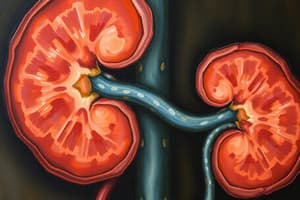Podcast
Questions and Answers
What is the primary purpose of conducting quantitative renal studies?
What is the primary purpose of conducting quantitative renal studies?
- To determine the genetic predisposition to renal disorders.
- To evaluate tubular and glomerular function quantitatively. (correct)
- To provide therapeutic interventions for renal disease.
- To analyze the histological structure of the kidneys.
Which methodology is NOT typically used in quantitative renal studies?
Which methodology is NOT typically used in quantitative renal studies?
- Camera-based methods to measure tracer accumulation.
- Use of 99mTc-pentetate for imaging.
- Blood sampling for tracer clearance estimation.
- Surgical biopsy for direct kidney tissue analysis. (correct)
What defines Effective Renal Plasma Flow (ERPF)?
What defines Effective Renal Plasma Flow (ERPF)?
- The ratio of blood to plasma cells in the kidneys.
- The volume of plasma that flows through the kidneys per minute. (correct)
- The total blood volume in the renal vasculature.
- The volume of urine produced by the kidneys per minute.
Which of the following substances was historically used for measuring renal plasma flow?
Which of the following substances was historically used for measuring renal plasma flow?
What is the normal range for Glomerular Filtration Rate (GFR) in mL/min?
What is the normal range for Glomerular Filtration Rate (GFR) in mL/min?
Flashcards
What is Effective Renal Plasma Flow (ERPF)?
What is Effective Renal Plasma Flow (ERPF)?
The volume of plasma that flows through the kidneys per minute. It measures renal tubular function.
What is Glomerular Filtration Rate (GFR)?
What is Glomerular Filtration Rate (GFR)?
A test that measures how much plasma is filtered by your kidneys each minute. It measures glomerular function.
How is ERPF measured?
How is ERPF measured?
99mTc-mertiatide is commonly used to measure ERPF. It measures how efficiently the kidneys are filtering waste products from the blood.
How is GFR measured?
How is GFR measured?
Signup and view all the flashcards
What are the normal values of ERPF and GFR?
What are the normal values of ERPF and GFR?
Signup and view all the flashcards
Study Notes
Quantitative Renal Studies
- Evaluate tubular and glomerular function numerically.
- Useful for monitoring renal pathology progression.
- Methodologies include blood sampling for tracer clearance and camera-based methods for measuring tracer accumulation.
Effective Renal Plasma Flow (ERPF)
- Measures renal tubular function.
- Typically performed after administering 99mTc-mertiatide.
- Defines the plasma volume flowing through the kidneys per minute.
- Historically measured using PAH (a non-radioactive substance).
- Estimation methods involve imaging, computer data processing, and blood/urine sample collection.
- Normal values range from 500-600 ml/min, varying by age and sex.
Glomerular Filtration Rate (GFR)
- Measures GFR using 99mTc-pentetate, as its renal uptake is proportional to GFR.
- GFR calculation methods utilize single blood samples or imaging with computer data processing.
- Normal GFR is 125 mL/min, varying by age and sex.
Studying That Suits You
Use AI to generate personalized quizzes and flashcards to suit your learning preferences.




